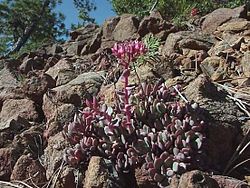| Sedum eastwoodiae | |
|---|---|
 | |
| Scientific classification | |
| Kingdom: | Plantae |
| Clade: | Tracheophytes |
| Clade: | Angiosperms |
| Clade: | Eudicots |
| Order: | Saxifragales |
| Family: | Crassulaceae |
| Genus: | Sedum |
| Species: | S. eastwoodiae |
| Binomial name | |
| Sedum eastwoodiae | |
| Synonyms [2] | |
Cotyledon mendocinoanaFedde Contents | |
Sedum eastwoodiae is a rare species of flowering plant of the stonecrop Crassulaceae family. [2] It is known by its common name Red Mountain stonecrop. It is endemic to Mendocino County, California, where it is known from only four occurrences on Red Mountain, near Ukiah. [1] [3] The total number of plants in existence is estimated to be around 5,300. [1] They can be found on steep, exposed, rocky mountain slopes of serpentine substrate. This species has also been treated as a subspecies of Sedum laxum . [4]
